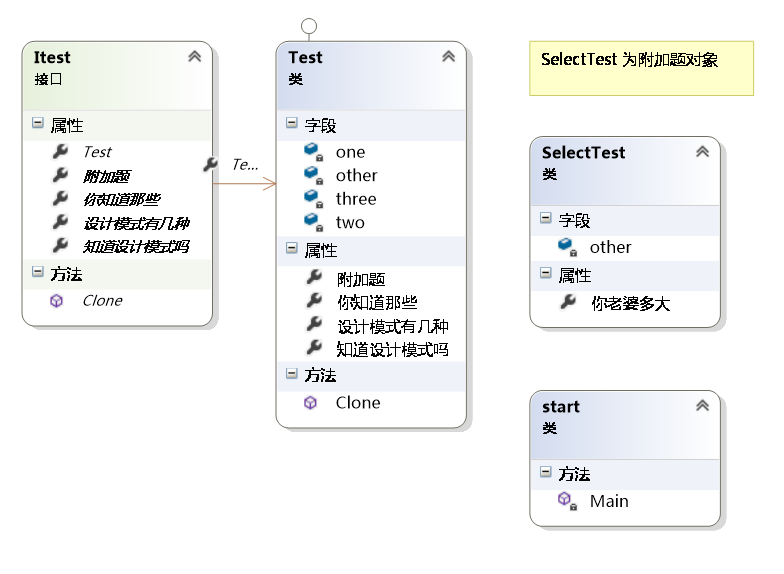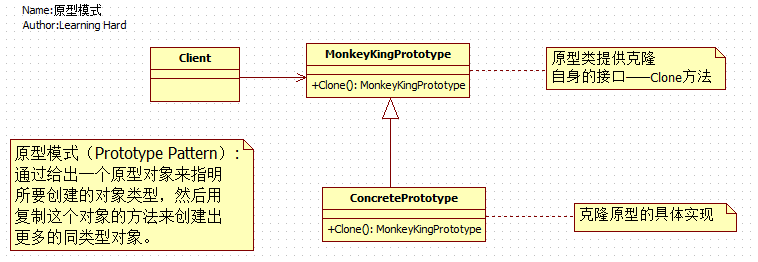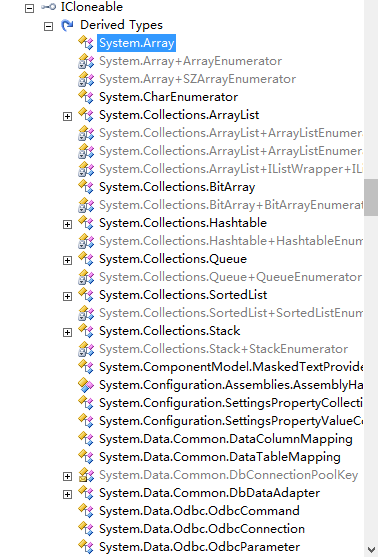一、引言
在软件系统中,当创建一个类的实例的过程很昂贵或很复杂,并且我们需要创建多个这样类的实例时,如果我们用new操作符去创建这样的类实例,这未免会增加创建类的复杂度和耗费更多的内存空间,因为这样在内存中分配了多个一样的类实例对象,然后如果采用工厂模式来创建这样的系统的话,随着产品类的不断增加,导致子类的数量不断增多,反而增加了系统复杂程度,所以在这里使用工厂模式来封装类创建过程并不合适,然而原型模式可以很好地解决这个问题,因为每个类实例都是相同的,当我们需要多个相同的类实例时,没必要每次都使用new运算符去创建相同的类实例对象,此时我们一般思路就是想——只创建一个类实例对象,如果后面需要更多这样的实例,可以通过对原来对象拷贝一份来完成创建,这样在内存中不需要创建多个相同的类实例,从而减少内存的消耗和达到类实例的复用。 然而这个思路正是原型模式的实现方式。下面就具体介绍下设计模式中的原型设计模式。
二、原型模式的详细介绍
我们来看一个入学考试场景实例
基对象(一般为接口,抽象类):考试题(样卷)
原型模式的复职克隆:根据需要印刷考卷,这里的考卷都是复制考试题样卷
客户端:学生答卷,同一套试卷,学生做题不可能一模一样
类图:

接口:试卷样例代码
/// <summary>
/// 选答题
/// </summary>
public class SelectTest
{
private string other;
public string 你老婆多大
{
get
{
return this.other;
}
set
{
this.other = value;
}
}
}
/// <summary>
/// 面试题
/// </summary>
public interface Itest
{
Itest Clone();
string 知道设计模式吗
{
get;
set;
}
string 设计模式有几种
{
get;
set;
}
string 你知道那些
{
get;
set;
}
SelectTest 附加题
{
get;
set;
}
Test Test
{
get;
set;
}
Test Test1
{
get;
set;
}
}
复制克隆:复印机
/// <summary>
/// 继承Itest接口
/// </summary>
public class Test : Itest
{
private string one;
private string two;
private string three;
private SelectTest other=new SelectTest();
public string 知道设计模式吗
{
get
{
return this.one;
}
set
{
this.one = value;
}
}
public string 设计模式有几种
{
get
{
return this.two;
}
set
{
this.two = value;
}
}
public string 你知道那些
{
get
{
return this.three;
}
set
{
this.three = value;
}
}
public SelectTest 附加题
{
get
{
return this.other;
}
set
{
this.other = value;
}
}
#region IColorDemo 成员
public Itest Clone()
{
//克隆当前类
return (Itest)this.MemberwiseClone();
}
#endregion
}
客户端,发卷做题
static void Main()
{
//印刷试卷
Itest test = new Test();
//复制样本试卷
Itest test1 = test.Clone();
//考生1
test.设计模式有几种 = "23";
test.附加题.你老婆多大 = "18";
//考生2
test1.设计模式有几种 = "24";
test1.附加题.你老婆多大 = "20";
//显示考生答卷内容
Console.WriteLine("test设计模式有几种:" + test.设计模式有几种); //23
Console.WriteLine("test附加题.你老婆多大:" + test.附加题.你老婆多大); //20
Console.WriteLine("test1设计模式有几种:" + test1.设计模式有几种); //24
Console.WriteLine("test1附加题.你老婆多大:" + test1.附加题.你老婆多大); //20
Console.ReadKey();
}
注意:这里两个人答得不一样,为什么附加题中,老婆年龄都为20?
这里涉及到深拷贝,浅拷贝问题,值类型是放在栈上的,拷贝之后,会自会在站上重新add一个,而class属于引用类型,拷贝之后,栈上重新分配啦一个指针,可指针却指向同一个位置的资源。浅拷贝,只拷贝值类型,深拷贝,引用类型也拷贝复制。
解决方案:
public Itest Clone()
{
//克隆当前类
Itest itst= (Itest)this.MemberwiseClone();
SelectTest st = new SelectTest();
st.你老婆多大 = this.other.你老婆多大;
itst.附加题 = st;
return itst;
}
使用序列化解决
/// <summary>
/// 选答题
/// </summary>
[Serializable]
public class SelectTest
{
private string other;
public string 你老婆多大
{
get
{
return this.other;
}
set
{
this.other = value;
}
}
}
/// <summary>
/// 面试题
/// </summary>
public interface Itest
{
Itest Clone();
string 知道设计模式吗
{
get;
set;
}
string 设计模式有几种
{
get;
set;
}
string 你知道那些
{
get;
set;
}
SelectTest 附加题
{
get;
set;
}
}
/// <summary>
/// 继承Itest接口
/// </summary>
public class Test : Itest
{
private string one;
private string two;
private string three;
private SelectTest other=new SelectTest();
public string 知道设计模式吗
{
get
{
return this.one;
}
set
{
this.one = value;
}
}
public string 设计模式有几种
{
get
{
return this.two;
}
set
{
this.two = value;
}
}
public string 你知道那些
{
get
{
return this.three;
}
set
{
this.three = value;
}
}
public SelectTest 附加题
{
get
{
return this.other;
}
set
{
this.other = value;
}
}
public Itest Clone()
{
SerializableHelper SerializableHelper = new 原型模式.SerializableHelper();
string target = SerializableHelper.Serializable(this);
return SerializableHelper.Derializable<Itest>(target);
}
}
public class SerializableHelper
{
public string Serializable(object target)
{
using (MemoryStream stream = new MemoryStream())
{
new BinaryFormatter().Serialize(stream, target);
return Convert.ToBase64String(stream.ToArray());
}
}
public object Derializable(string target)
{
byte[] targetArray = Convert.FromBase64String(target);
using (MemoryStream stream = new MemoryStream(targetArray))
{
return new BinaryFormatter().Deserialize(stream);
}
}
public T Derializable<T>(string target)
{
return (T)Derializable(target);
}
}
这就是对原型模式的运用。介绍完原型模式的实现代码之后,下面看下原型模式的类图,通过类图来理清原型模式实现中类之间的关系。具体类图如下:

三、原型模式的优缺点
原型模式的优点有:
原型模式向客户隐藏了创建新实例的复杂性
原型模式允许动态增加或较少产品类。
原型模式简化了实例的创建结构,工厂方法模式需要有一个与产品类等级结构相同的等级结构,而原型模式不需要这样。
产品类不需要事先确定产品的等级结构,因为原型模式适用于任何的等级结构
原型模式的缺点有:
每个类必须配备一个克隆方法
配备克隆方法需要对类的功能进行通盘考虑,这对于全新的类不是很难,但对于已有的类不一定很容易,特别当一个类引用不支持串行化的间接对象,或者引用含有循环结构的时候。
四、.NET中原型模式的实现
在.NET中可以很容易地通过实现ICloneable接口(这个接口就是原型,提供克隆方法,相当于与上面代码中MonkeyKingPrototype抽象类)中Clone()方法来实现原型模式,如果我们想我们自定义的类具有克隆的功能,首先定义类继承与ICloneable接口并实现Clone方法。在.NET中实现了原型模式的类如下图所示(图中只截取了部分,可以用Reflector反编译工具进行查看):
